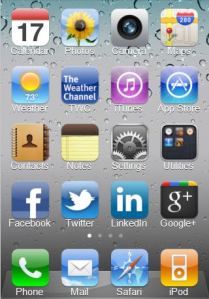By: Karen Pelletier
Many companies are racing to create their own apps for smartphones. But does this really make sense for every company?
At one point in my career I studied the sauces and condiments category. The primary constraint for the purchase of new types of sauces and condiments was refrigerator shelf space. Using IRI and NPD Diary Panel data I discovered that the size of the product category (like mayonnaise or ketchup) could be predicted by how versatile it was (the number of things you used that sauce or condiment on) and how frequently you made those dishes that the sauce or condiment was used in.
For example, I could predict that Dijonnaise (the combination of mayonnaise and Dijon mustard) would never be a large category because it’s not very versatile (compared to mayonnaise or Dijon mustard), and you are probably not going to use it on a lot of things—low frequency or quantity of use. Do you want to devote precious refrigerator shelf space to something you are not going to use all that much and that you can make out of products you probably already have on hand?
I would argue that the “app” market is very similar to the sauces and condiments category. In this case, the shelf space constraint is the number of screens/folders you have to scroll through to find the app. Versatility is how many different things you are going to use that app for, and frequency is how many times you are likely to use it for each of its functions.
In addition to my own experience with apps, Danny Sullivan, Editor and Chief of Search Engine Land, provided his anecdotal substantiation for my theory in one of his blog postings. Danny observed that he originally used the check-in/gaming features of Foursquare, but now it was becoming his go-to local search tool app because he used it for recommendations on where to eat, what to eat, to find nearby specials, and as a mapping tool. This versatility, using it for many functions, like where and what to eat, and location mapping, and the fact that these are things that Danny searches for often (frequency) make Foursquare a valuable app for him.
One final predictor is uniqueness. If you are the 4th or 5th app out there to perform a variety of functions, but there is nothing meaningfully unique that your app does, then don’t expect to succeed. I used to use Trip Advisor all the time to look for recommendations on where to eat and to check reviews, but Open Table offered the ability to instantly make a reservation at the restaurant I decided upon. That was their positioning, their unique point of difference, that enabled the Open Table app to make it into my head and onto my phone.
Marketing Takeaway: If you are planning an app for your business, make sure it’s an app that is versatile (can be used for many things), that those things are likely to be used frequently by your target market, and that you are bringing something unique and meaningful to the party. If not, you should focus your efforts on creating a mobile site and on being found by your target market when they search for your product or service.
I would love to test this hypothesis quantitatively. If you have any ideas of where I could find data on the number of times apps have been downloaded, the number of things people use those apps for, and the frequency with which they use them I would be eternally grateful!

